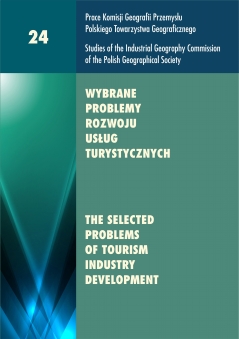Tourism Cluster and Tourism Destination: Liptov Region, Slovakia
DOI:
https://doi.org/10.24917/20801653.24.2Słowa kluczowe:
Fordist mass tourism, Liptov, Slovakia, tourism cluster, tourism destinationAbstrakt
In connection with development of tourism areas, some studies based on the concept of clustersappear. The term “cluster” is used in scientific literature to denote a strong tendency for networkingof economic activities and for their spatial concentration. Networks and active participation of individualplayers (municipalities, firms, etc.) of these networks are the core features of clusters. Networkrelationships are particularly important for the sector of tourism, where groups of organizations try tocluster together so as to cooperate and form a tourism destination.The aim of the paper is to present interconnection between (tourism) cluster as a theoretical conceptand the Liptov region as a tourism destination. The first attempt of Slovak tourism cluster establishmentin the region of Liptov is shortly introduced and assessed by describing the crucial players (with their“philosophy” of mass tourism production and consumption). The second part of the paper is connectedwith statistical evaluation of the development of the regional tourism under the influence of the ClusterLiptov.Downloads
Bibliografia
Dado, M. et al. (2006). Rámcová stratégia Žilinského regiónu pre oblasť inovačného rozvoja. Žilinská univerzita, Žilina (http://www.zip.utc.sk).
Klaster Liptov – 1. slovenská organizácia destinačného manažmentu (DMO) (http://www.klaster liptov.sk).
Nordin, S. (2003). Tourism Clustering and Innovations, no.14, ETOUR Mid-Sweden University, Östersund.
Novelli, M., Schmitz, B., Spencer, T. (2006). Networks, Clusters and Innovation in Tourism: A UK experience. Tourism Management, 27, 1141–1152.
Porter, M. (1990). The Competitive Advantage of Nations, New York: The Free Press.
Porter, M. (1998). On Competition. Harvard Business School Press.
Smeral, E. (1998). The Impact of Globalization on Small and Medium Enterprises: New Challenges for Tourism Policies in European Countries. Tourism Management, 19(4), 371–380.
Székely, V. (2003). Tourism in Rural Areas of Slovakia: Economic Development and/or Sustainable Development? Geopolitical Studies, 11 – Eastern Dimension of European Union, 251–264.
Székely, V. (2010). Tourism Clusters as a Tool for the Improvement of Rural Competitiveness: First Experiences from Slovakia. In: A. Fieldsend (ed.), Rural Areas and Development, 7 – Linking Competitiveness with Equity and Sustainability: New Ideas for the Socio-Economic Development of Rural Areas. Warsaw (European Rural Development Network), 109–120.
Štatistický úrad Slovenskej republiky, Bratislava (http://portal.statistics.sk).
Torres, R. (2002). Cancun’s Tourism Development from a Fordist Spectrum of Analysis. Tourist Studies, 2(1), 87–116.
Tatry mountain resorts, a.s., Liptovský Mikuláš (http://www.tmr.sk).
Więckowski, M., Michniak, D., Bednarek-Szczepańska, M., Chrenka, B., Ira, V., Komornicki, T., Rosik, P., Stępniak, M., Székely, V., Sleszyński, P., Świątek, D., Wiśniewski, R. (2012a). Poľsko-slovenské pohraničie z hľadiska dopravnej dostupnosti a rozvoja cestovného ruchu. Varšava – Bratislava: Instytut Geografii i Przestrzennego Zagospodarowania, Polska Akademia Nauk, Geografický ústav Slovenskej akadémie vied.
Więckowski, M., Michniak, D., Chrenka, B., Ira, V., Komornicki, T., Rosik, P., Székely, V., Sleszyń-ski, P., Wiśniewski, R. (2012b). Možnosti zlepšenia dostupnosti a rozvoja cestovného ruchu v poľsko-slovenskom pohraničí – námety, odporúčania a dobré príklady. Varšava–Bratislava: Instytut Geografii i Przestrzennego Zagospodarowania, Polska Akademia Nauk, Geografický ústav Slovenskej akadémie vied.
Pobrania
Opublikowane
Jak cytować
Numer
Dział
Licencja
Artykuły publikowane są zgodnie z warunkami licencji Creative Commons (CC BY-ND 4.0; uznanie autorstwa-bez utworów zależnych).

